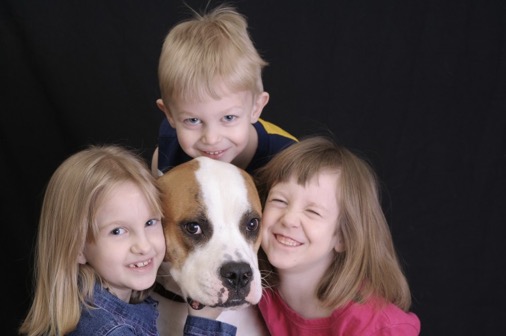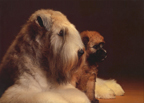Robin Bennet
It’s sound advice given frequently: Supervise your dogs and kids while they are together. Breeders warn parents, “Don’t leave the dog alone with children, no matter how friendly the breed.” Veterinarians advise, “Never leave a dog and a child in the same room together.” Dog trainers explain, “All dogs can bite so supervise your dog when you have children over.” Everyone knows the drill. So why doesn’t it work? Why are there an estimated 800,000 Americans seeking medical attention for dog bites each year, with over half of these injuries to children ages 5-9?

Note the good intentions of the kids. Note the closed mouth and half-moon eye of the dog. Intervene.
The bites are not a result of negligent parents leaving Fido to care for the baby while mom does household chores, oblivious to the needs of her children. In fact, I’ve consulted on hundreds of dog bite cases and 95% of the time the parent was standing within 3 feet of the child watching both child and dog when the child was bitten. Parents are supervising. The problem is not lack of supervision. The problem is no one has taught parents what they should be watching.
Parents generally have not received any education on what constitutes good dog body language and what constitutes an emergency between the dog and the child. Parents generally have no understanding of the predictable series of canine body cues that would indicate a dog might bite. And complicating matters further, most parents get confused by the good intentions of the child and fail to see when a dog is exhibiting signs of stress. The good new is all of this is easy to learn! We can all get better at this.
Here is a simple list to help you improve your supervision skills:
Watch for loose canine body language. Good dog body language is loose, relaxed, and wiggly. Look for curves in your dog’s body when he is around a child. Stiffening and freezing in a dog are not good. If you see your dog tighten his body, or if he moves from panting to holding his breath (he stops panting), you should intervene. These are early signs that your dog is not comfortable.
Watch for inappropriate human behavior. Intervene if your child climbs on or attempts to ride your dog. Intervene if your child pulls the ears, yanks the tail, lifts the jowls or otherwise pokes and prods the dog. Don’t marvel that your dog has the patience of Job if he is willing to tolerate these antics. And please don’t videotape it for YouTube! Be thankful your dog has good bite inhibition and intervene before it’s too late.
Watch for these three really easy to see stress signals in your dog. All of them indicate you should intervene and separate the child and dog:
Yawning outside the context of waking up
Half-moon eye – this means you can see the whites on the outer edges of your dog’s eyes.
Lip licking outside the context of eating food
Watch for avoidance behaviors. If your dog moves away from a child, intervene to prevent the child from following the dog. A dog that chooses to move away is making a great choice. He’s saying, “I don’t really want to be bothered, so I’ll go away.” However, when you fail to support his great choice and allow your child to continue to follow him, it’s likely the dog’s next choice will be, “Since I can’t get away, I’ll growl or snap at this kid to get the child to move away.” Please don’t cause your dog to make that choice.
Listen for growling. I can’t believe how many times I’ve heard parents say, “Oh, he growled all the time but we never thought he would bite.” Dog behavior, including aggression, is on a continuum. For dogs, growling is an early warning sign of aggression. Heed it. If growling doesn’t work, the dog may escalate to snapping or biting. Growling is a clue that you should intervene between the dog and the child.
To pet owners, particularly those who also have children, thank you for supervising your dog! As a dog trainer and mother of two, I know that juggling kids and dogs is no easy feat. It takes patience, understanding, and a great deal of supervision. I hope these tips will help you get better at supervising.

